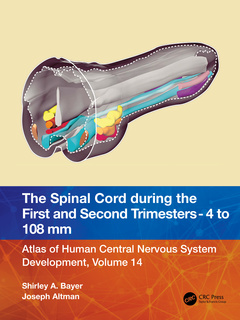Description
The Spinal Cord during the First and Early Second Trimesters 4- to 108-mm Crown-Rump Lengths
Atlas of Central Nervous System Development, Volume 14
Authors: Bayer Shirley A., Altman Joseph
Language: English
Subjects for The Spinal Cord during the First and Early Second...:
Keywords
Publication date: 06-2024
· 21x28 cm · Hardback
Publication date: 06-2024
· 21x28 cm · Paperback
Description
/li>Contents
/li>Readership
/li>Biography
/li>
This fourteenth of 15 short atlases reimagines the classic 5 volume Atlas of Human Central Nervous System Development. This volume presents sections of the spinal cord from specimens between 4 mm and 108 mm with detailed annotations. Extensive 3-D reconstructions show the early development of the germinal zones, the earliest neurons and early white matter accumulations at cervical levels only. Other 3-D reconstructions in older specimens show the progressive segregation of motor neuron columns at all levels in the ventral gray.
The Glossary (available separately) gives definitions for all the terms used in this volume and all the others in the Atlas.
Key Features
- Classic anatomical atlases
- Detailed labeling of the structures in the developing spinal cord offers updated terminology and the identification of unique developmental features, such as germinal matrices of specific neuronal populations and migratory streams of young neurons
- Appeals to neuroanatomists, developmental biologists, and clinical practitioners
A valuable reference work on brain development that will be relevant for decades
PART I. INTRODUCTION------------------------------------------------------------------------------ 1
Organization of the Atlas--------------------------------------------------------------------- 1
Spinal Cord Anatomy-------------------------------------------------------------------------- 2
Developmental Highlights-------------------------------------------------------------------- 5
PART II. Cervical Levels of the Early to Middle First Trimester------------------------------ 8
Overview Plate 1 9
Plates 2–12 A/B 24-39
PART III. 36-mm Crown-Rump Length, M2050--------------------------------------------------- 40
Overview Plate 13 41
Plates 14–20 A/B 72-105
PART IV. 56-mm Crown-Rump Length, Y380-62------------------------------------------------- 48
Overview Plate 21 49
Plates 22–28 A/B 50-63
PART V. 105-mm Crown-Rump Length, Y68-65------------------------------------------------- 64
Overview Plate 29 65
Plates 30–37 A/B 66-79
PART VI. 3-D Reconstructions of the Cervical Level of Eight
First Trimester Specimens------------------------------------------------------------- 82-99
PART VII. 3-D Reconstructions of the Progressive Segregation
of Ventral Horn Motor Neurons into Columns------------------------------- 101-139
Shirley A. Bayer received her PhD from Purdue University in 1974 and spent most of her scientific career working with Joseph Altman. She was a Professor of Biology at Indiana-Purdue University in Indianpolis for several years, where she taught courses in Human Anatomy and Developmental Neurobiology while continuing to do research in brain development. Her lengthy publication record of dozens of peer reviewed scientific journal articles extends back to the mid 1970's. She has co-authored several books and many articles with her late spouse, Joseph Altman. It was her research (published in Science in 1982) that proved that new neurons are added to granule cells in the dentate gyrus during adult life, a unique neuronal population that grows. That paper stimulated interest in the dormant field of adult neurogenesis.
Joseph Altman, now deceased, was born in Hungary and migrated with his family via Germany and Australia to the United States. In New York, he became a graduate student in psychology in the laboratory of Hans-Lukas Teuber, earning a PhD. in 1959 from New York University. He was a postdoctoral fellow at Columbia University, and later joined the faculty at the Massachusetts Institute of Technology. In 1968, he accepted a position as a Professor of Biology at Purdue University. During his career, he collaborated closely with Shirley A. Bayer. From the early 1960s to 2016. He published many articles in peer-reviewed journals, books, monographs, and online free books that emphasized developmental processes in brain anatomy and function. His most important discovery was adult neurogenesis, the creation of new neurons in the adult brain. This discovery was made in the early 1960s while he was based at MIT and was largely ignored in favor of the prevailing dogma that neurogenesis is limited to prenatal development. After Shirley’s paper proved that new neurons are adding to granule cells in the hippocampus, Altman’s monumental discovery
These books may interest you

Clinical NeuroembryologyDevelopment and Developmental Disorders of the Human Central Nervous System 242.64 €

Atlas of Functional Neuroanatomy 87.11 €


